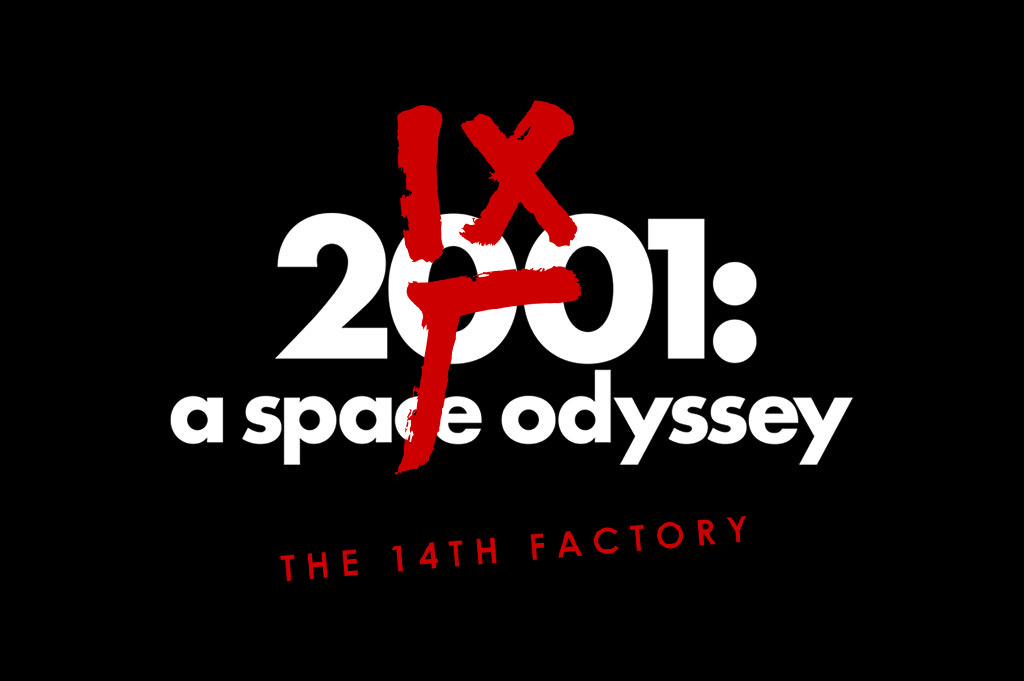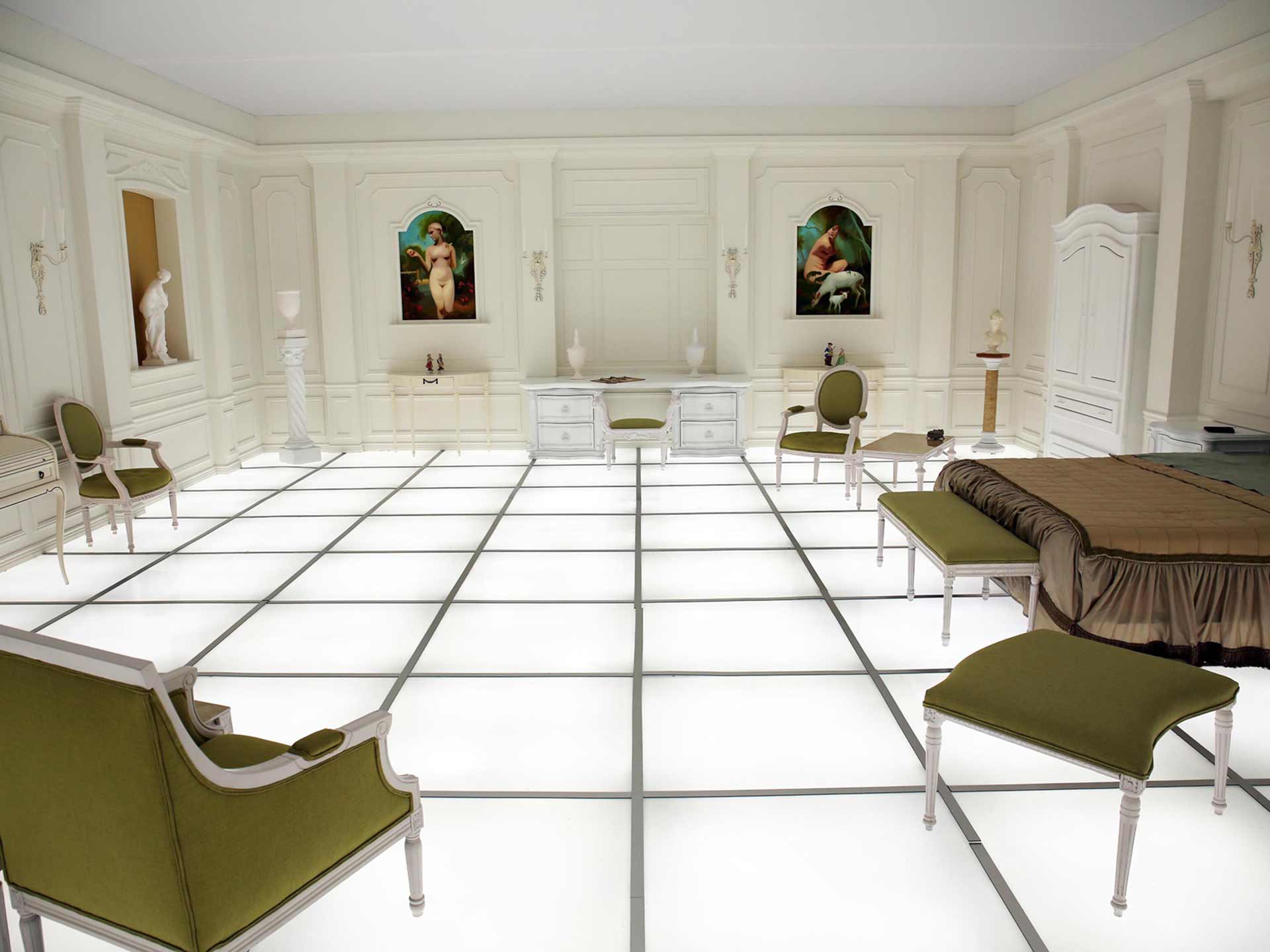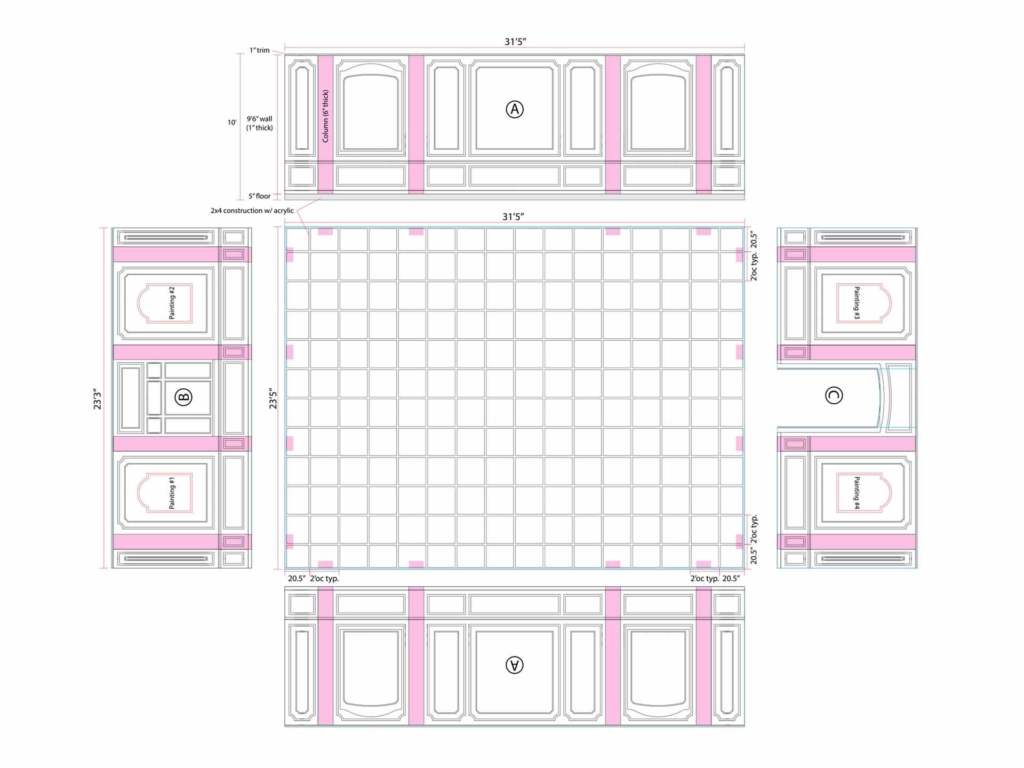
The Artist discusses his full-scale recreation of the iconic, future-Baroque set from Kubrick’s landmark film 2001: A Space Odyssey.
created for the blockbuster collective exhibition The 14th Factory, the installation went on to be displayed at the Smithsonian National Air & Space Museum.
SPLENDOID: Jumping straight in, I know the rough story, but could you outline how the project came about?
BIRCH: It’s the most recent result of incremental progress over many years spent innovating with limited resources and lack of support for the arts here in Hong Kong.
With no art museum or other opportunity, friends and I started building experimental collaborative projects in whatever space we could find, funding them from my income as a painter.
Although I came to HK with no real plan and then working as a laborer in construction, my hobby as a painter outpaced my day job income to the point that I could rent space and fund films and installations.
The project got bigger and as Hong Kong became more and more expensive and space less readily available, we looked overseas. After some years of absolute failure, we finally were able to deliver a large scale, multiple media, collaborative, singular narrative, experience, in Lincoln Heights in LA.
In short, a 14 part journey down the rabbit hole through gardens and cinemas and galleries, though science fiction and heroes and villains and violence and love and transformation.
The final exhibition was an incredibly mixed bag of different approaches and disciplines. I wonder if you had any kind of theme that drove it all?
It follows the work of Joseph Campell and Karl Jung. We followed the principals of the hero myth. So the project works in a loose procession, each piece being a step on the familiar journey; down the rabbit hole, into wonderland, adversity, guidance, good and evil, a task, reward, transformation. And with our group of collaborators, the films, music and installations, further infuse the project with the contemporary conversation, the tension between border and border less. The name being taken from 19th century China, the 13th Factories of Canton, as the west forced the borders open during the opium wars which led to the collapse of dynastic China, the emergence of the republic and the communist revolution, transformed finally to new the China in 1997 when the British exited from Hong Kong, The year I arrived.

Like many probably, you have said that you always wanted to rebuild this set. Was the intention always to do it as an exhibition piece or was it more like you would have liked to do an interior design concept or something?
In the structure of any monomyth, there is always an inner cave. We had always planned a clean white space on the interior of a large chaotic exterior, inspired by Labbeus Woods and Frank Miller which is a whole other story. The inner room was always inspired by the prison for the astronaut from 2001: A Space Odyssey. I always like to sneak in my personal nods to my inspirations. And make sure people know nothing is original.
When we approached friends here who are in design, we remarkable discovered their family had actually been Kubrick’s team on that movie and built that actual room. And though there was little in the way of models, measurements, blueprints, as Kubrick destroyed it all, we were able to get enough information from grandpa to be very precise.
The opportunity to build this iconic room exactly, a room that doesn’t exist other than on film, was just too exciting to pass on. So we went from room inspired by, to total scale copy with every detail. It was so much fun. And the audience loved it too.
What was it about this set that you felt would make a great installation?
Well first was just the random, serendipity that gave us the direct line to that sets heritage like it was meant to be. But it fit the overarching narrative very well, violence, being a prison, and death and transformation. The show with all its parts is a compressed human experience. The metaphor, history, synergy, and my personal affection for the film…it all just felt right. Initially, the room was not available for the public, only via a tiny crack, so it was a secret. But the fire department made us make the front entrance open. Naively it was a surprise what a big hit it was.
The opportunity to build this iconic room exactly, a room that doesn’t exist other than on film, was just too exciting to pass on
What are you trying to communicate by recreating such an icon of popular culture?
Well, there’s the excitement of the opportunity, the serendipity…then there’s also the fact that I wanted to communicate that all my work comes from somewhere else which is a blatant comment about influence…it also fulfilled that piece the journey of the entire 14th Factory project. It was meant to be in many ways
What was the cost of your build roughly?
100k
Any idea of how that compared with the cost of the original set?
Way cheaper but we nailed it. we had visitors from Kubricks side who were very impressed and obviously our friends who built the original one for Stanley said we nailed it.
How did you plan the build? I know that ‘Uncle Tony’ was a big part of the process but how did you all sit down and start? Was it a case of watching the film and creating CAD drawings? Or perhaps there were still original plans somewhere? I never saw them in the Kubrick Archive, although I hoped, and looked hard!
First I pitched the idea of this white room inspired by the movie. Then found out Kubrick destroyed it all. Then felt compelled to recreate it rather than just give it a nod. Then found out our mates here in HK were party of the whole story with tier elder relatives and then felt somewhat obliged to make it happen.
Watched the film, images across the studio wall, finding out heights of actors to scale things, feeding back to the oldies to get their comments. Was an energised experience and fun for all. Only limits and frustrations were always money and still are. Could never find funding or sponsors so the whole project was built on innovation and very little money.
But yeh, CAD drawings generated from all the above and the off to production factory to build and a great girl in LA, Desiree Neill who killed it on furniture and details.
Could you outline the total process of the work, from inception to completion?
That’s difficult to recall as it was slow and steady over a year maybe and was originally supposed to go into a space in NYC and the we just couldn’t get the financial support there and had take the whole show to LA on the edge of bankruptcy, which meant we then had to on set, re scale the whole room to fit new parameters.
It’s been a drama. when we finally opened we were already facing closure as we couldn’t make rent and had to cut all PR and marketing, even cleaning staff (cleaning toilets when you’re the principal artist on one of the biggest art installations of it’s type in the world is quite the humbling experience) to save money so few people even knew about it. but then social media kicked in, the celebs followed and by the end we were doing 10,000 people a day and hour long lines to get a selfie in that room

Was it built 1 to 1 scale or did you have to change any physical sizes due to location restrictions, for example?
It’s one to one and perfect in most details other than the paintings which were re-interpreted by Dominique Fong.
How big was the final build in terms of spatial area?
The whole show was over 150,000sqft and the white room was only maybe 3000sqft.
What was the most difficult bit to accomplish
Money obviously. No one would sponsor us. No funding. Odd neigbourhood, hard to get to, that we loved but other people were afraid of there because of it’s violent reputation (we had no incidents and the community were simply wonderful). We ran as a non-profit, only charged $15 to get in and had no advertising. It should have been an absolute failure. But through word of mouth, 100k people came and for many it was he most meaningful art interaction they had ever had. From the Mayor to the celebs to the hispanic families down the street. It meant something. Maybe because it was somewhat a miracle that it ever happened.
And was there any part of the build that you weren’t able to match?
For the room, we never did find out the original artworks though we scoured libraries and online for those neo-classical, rococo, or whatever they were, paintings. So we gave up and bought Dominique in. She killed it.
How did you source the props?
Desiree Neill based in LA built them all. Amazing.
Where there any that proved particularly difficult to find?
What she couldn’t source, she hand made.
We never did find out the original artworks though we scoured libraries and online for those classical, rococo, or whatever they were, paintings. So we gave up and bought Dominique in.
She killed it.
My feeling is that Kubrick was one of the last great artists after the classical tradition, he just happened to find his voice in genre film-making. He famously destroyed the 2001 sets to stop the practice of recycling sets rife in 1960s UK film-making. Your work is a chance for people to become a part of that great heritage, to witness it and perhaps become part of it. Would you agree?
I wanted to make a statement to recognize my ignition points throughout the show and the Kubrick room is the most obvious. But I’ve got that out the way and my future projects are off on a whole new conversation. And I’m conscious of the danger in things like that room becoming a novelty and a cheap trick. I doubt it will be in the next project. Didn’t help that we got a threatening letter from WB either! But then they were perfectly nice about the whole thing when we spoke.
Do you see the work as fitting into the tradition of ‘total installation,’ created by such artists as Ilya Kabakov, Mike Nelson, Thomas Hirschorn, much of which is influenced by cinema also?
Each to their own. But I like film and that’s why my project is like walking through a film. Better than walking around an art fair or a posh gallery where the staff look at you like you don’t belong and feel nothing.
Some critics of this kind of immersive installation work have deemed it just entertainment and escapism rather than serious artworks. As yours has that extra layer of coming from a feature film it opens itself for even more of that type of criticism, that such pieces are ultimately vacuous festival is and spectacle. With your work it could be argued that any meaning in the piece comes from Kubrick and C Clarke, not from you as the author/artist. How would you answer that?
I already mentioned the root of hero myth structure that certainly didn’t come from me but we embraced it because we all feel the current tensions, divisions, lack of empathy in the world. Perhaps we are attempting to take action with this borderless environment that is not about ownership but experience.
It’s a work in progress for sure, a potential incubator in new ways or presentation and production, a place of cross pollination (we are now working with Smithsonian and the Gates Foundation as well as being supported by architects Zaha Hadid) and the challenges of funding, space make it all far slower and painful than I would like. But then I guess to do anything this scale, outside the established art world, what do you expect? No one has done this before because it ain’t easy.
Sure, I take from Arthur C Clarke, Asimov, Ian Banks, Alan Moore, Frank Miller, Crass, Bauhaus, Skepta, and George Lucas as much as Warhol and Basquiat. Who doesn’t? I’m doing the best I can with limited resources and my limited intellect and it’s all a work in progress. More to come I hope.


What do you believe is the ongoing attraction of Kubrick as a filmmaker and 2001 particularly?
Seriously? Just watch his movies. Pretty clear.
Why would you say that this set has captured the public imagination in particular? There seem to be references to it everywhere.
It’s heaven and hell in one but ultimately where the captor transforms. Don’t we all want to just survive this round and level up to something more? I’m ready for space baby anytime. Sick of this life which is such pretty and terrifying construct.
And what happens with the sculpture after the installation is over?
We have no money so straight to the trash pile. I think people always assume with a project like this there’s a brand behind it and money and support. This was not the case. I sold everything I had, borrowed money from friends and the only support we got was people we worked with working for cheap or free because they simply wanted to see it alive. We got a bunch of free bourbon from Bullitt Bourbon so that was nice.
Post the show’s close, when the landlord kicked us out I started looking for waiter jobs and had to sell anything of value just to cover the cost of dumping the whole exhibition, tried to find new space or rich people to help us stay alive but no luck. So many people told us it was the best show they had ever seen and we met celebs and art world, LACMA acquired one of the video installations, the Mayor took me out for dinner, but we couldn’t find anyone that would help financially.
But there’s light at the end of the tunnel. I have convinced a group of very smart people to help me re-structure the business end of the project, create a new proposal, run it as a commercial project that relies on ticket sales and other revenues streams and we may now have new investors and hope to build multiple projects around the world on a huge scale. Within the next few weeks, we may well be fully funded and ready to get back to work.
